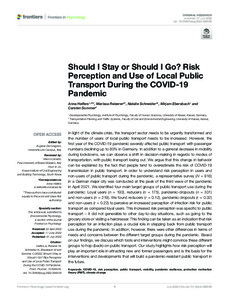| dc.date.accessioned | 2022-08-22T14:16:33Z | |
| dc.date.available | 2022-08-22T14:16:33Z | |
| dc.date.issued | 2022-07-07 | |
| dc.identifier | doi:10.17170/kobra-202208226723 | |
| dc.identifier.uri | http://hdl.handle.net/123456789/14091 | |
| dc.description.sponsorship | Gefördert durch den Publikationsfonds der Universität Kassel | ger |
| dc.language.iso | eng | |
| dc.rights | Namensnennung 4.0 International | * |
| dc.rights.uri | http://creativecommons.org/licenses/by/4.0/ | * |
| dc.subject | COVID-19 | eng |
| dc.subject | risk perception | eng |
| dc.subject | public transport | eng |
| dc.subject | mobility | eng |
| dc.subject | pandemic resilience | eng |
| dc.subject | protection motivation theory (PMT) | eng |
| dc.subject | climate change | eng |
| dc.subject.ddc | 150 | |
| dc.subject.ddc | 380 | |
| dc.title | Should I Stay or Should I Go? Risk Perception and Use of Local Public Transport During the COVID-19 Pandemic | eng |
| dc.type | Aufsatz | |
| dcterms.abstract | In light of the climate crisis, the transport sector needs to be urgently transformed and the number of users of local public transport needs to be increased. However, the first year of the COVID-19 pandemic severely affected public transport with passenger numbers declining up to 80% in Germany. In addition to a general decrease in mobility during lockdowns, we can observe a shift in decision-making in regards to modes of transportation, with public transport losing out. We argue that this change in behavior can be explained by the fact that people tend to overestimate the risk of COVID-19 transmission in public transport. In order to understand risk perception in users and non-users of public transport during the pandemic, a representative survey (N = 918) in a German major city was conducted at the peak of the third wave of the pandemic in April 2021. We identified four main target groups of public transport use during the pandemic: Loyal users (n = 193), reducers (n = 175), pandemic-dropouts (n = 331) and non-users (n = 219). We found reducers (r = 0.12), pandemic-dropouts (r = 0.32) and non-users (r = 0.22) to perceive an increased perception of infection risk for public transport as compared loyal users. This increased risk perception was specific to public transport – it did not generalize to other day-to-day situations, such as going to the grocery store or visiting a hairdresser. This finding can be taken as an indication that risk perception for an infection plays a crucial role in stepping back from public transport use during the pandemic. In addition, however, there were other differences in terms of needs and concerns between the different target groups during the pandemic. Based on our findings, we discuss which tools and interventions might convince these different groups to hop-(back)-on public transport. Our study highlights how risk perception will play an important role in attracting new and former passengers and is the basis for the interventions and developments that will build a pandemic-resistant public transport in the future. | eng |
| dcterms.accessRights | open access | |
| dcterms.creator | Helfers, Anna | |
| dcterms.creator | Reiserer, Marissa | |
| dcterms.creator | Schneider, Natalie | |
| dcterms.creator | Ebersbach, Mirjam | |
| dcterms.creator | Sommer, Carsten | |
| dc.relation.doi | doi:10.3389/fpsyg.2022.926539 | |
| dc.subject.swd | Deutschland | ger |
| dc.subject.swd | COVID-19 | ger |
| dc.subject.swd | Personennahverkehr | ger |
| dc.subject.swd | Mobilität | ger |
| dc.subject.swd | Zielgruppe | ger |
| dc.subject.swd | Resilienz | ger |
| dc.subject.swd | Kundenmanagement | ger |
| dc.subject.swd | Klimaschutz | ger |
| dc.subject.swd | Klimaänderung | ger |
| dc.type.version | publishedVersion | |
| dcterms.source.identifier | eissn:1664-1078 | |
| dcterms.source.journal | Frontiers in Psychology | eng |
| dcterms.source.volume | Volume 13 | |
| kup.iskup | false | |
| dcterms.source.articlenumber | 926539 | |


